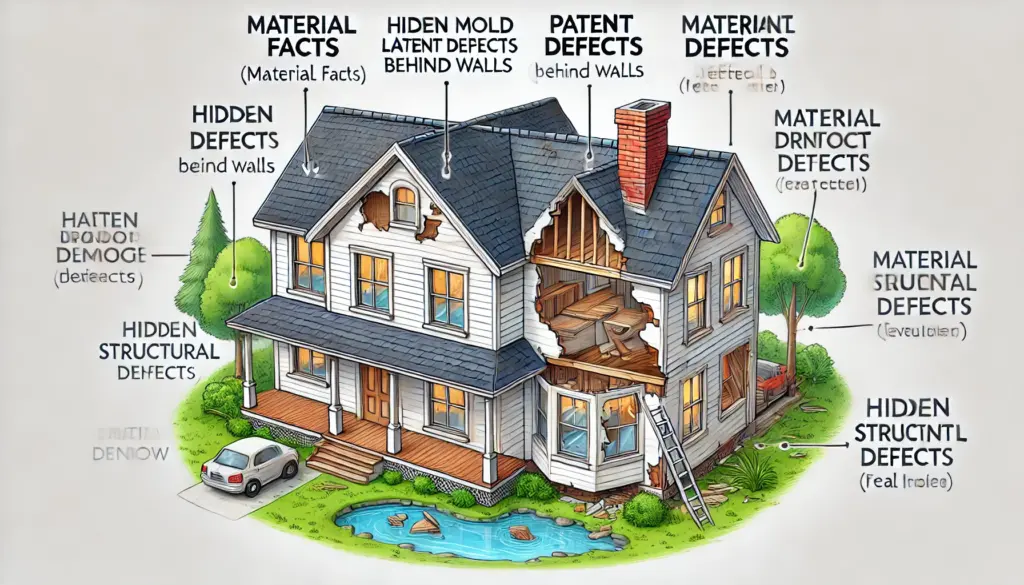In real estate, there are crucial terms that both buyers and sellers need to understand: material facts, latent defects, patent defects, and material latent defects. Let’s delve deeper into these concepts with examples from both buyers’ and sellers’ perspectives.
Material Facts
A material fact is any information that can influence a buyer’s decision to purchase a property. These facts are crucial because they provide a clear picture of the property’s condition and value.
Buyer’s Perspective:
- Example: Sarah is looking to buy a house. She finds a property that seems perfect. However, she learns that the house is in a flood zone. This is a material fact because it might make her reconsider buying the house due to potential flooding risks and higher insurance costs.
Seller’s Perspective:
- Example: John is selling his home. He knows that a new shopping mall will be built nearby in the next year. This is a material fact that he should disclose because it could increase the property’s value and influence a buyer’s decision.
Latent Defects
Latent defects are problems with a property that are not immediately visible or obvious, even with a thorough inspection. These defects are hidden and often discovered after the purchase.
Buyer’s Perspective:
- Example: Mike buys an older home and moves in. A few months later, he notices a musty smell and discovers mold behind the walls, which was not visible during the inspection. This mold is a latent defect because it was hidden and not detectable at the time of purchase.
Seller’s Perspective:
- Example: Jane is selling her home. She knows that there is a small crack in the foundation covered by drywall, which could lead to water leakage. This is a latent defect. Jane should disclose this information because, even though it is not visible, it can cause significant problems later on.
Patent Defects
Patent defects are problems that are easily visible or discoverable during a normal inspection. These defects are obvious and can be seen without any special tools or inspections.
Buyer’s Perspective:
- Example: Emma tours a house and notices that several windows are broken and there is peeling paint on the exterior walls. These are patent defects because they are visible and can be seen during a walkthrough.
Seller’s Perspective:
- Example: Tom is selling his house. He knows the roof has missing shingles, which is an obvious issue. Since this is a patent defect, Tom doesn’t need to worry about hiding it, as buyers will see it during their inspection.
Material Latent Defects
Material latent defects are hidden problems that significantly affect the property’s value or the safety of its occupants. These defects are not easily discovered but have serious implications.
Buyer’s Perspective:
- Example: Anna buys a house and later discovers that the electrical wiring is outdated and poses a fire hazard. This is a material latent defect because it is a hidden issue that affects the safety of the home and requires costly repairs.
Seller’s Perspective:
- Example: Mark is selling his home and knows there is a severe termite infestation in the basement that is not visible. This is a material latent defect. Mark should disclose this to potential buyers because it can affect the property’s value and safety.
Differences Between Material Facts and Defects
Understanding the differences between material facts and defects is crucial for clear communication and transparency in real estate transactions.
- Material Facts: Include all significant information that can influence a buyer’s decision, such as property location, legal issues, zoning changes, or major repairs needed. For example, knowing that a property is subject to a pending zoning change that will allow commercial development is a material fact.
- Latent Defects: Hidden problems not easily seen or discovered during an inspection, like concealed water damage in the basement.
- Patent Defects: Obvious issues that can be seen during an inspection, such as a broken front door or damaged flooring.
- Material Latent Defects: Serious hidden problems that can affect the property’s value or safety, such as a hidden structural issue that requires extensive repair.
Summary
Understanding these terms helps both buyers and sellers communicate clearly and ensures all important information is shared during a real estate transaction. Sellers should disclose any known material facts and defects to maintain transparency, while buyers should conduct thorough inspections and ask pertinent questions to uncover any potential issues. This mutual understanding fosters trust and smooth transactions in the real estate market.



